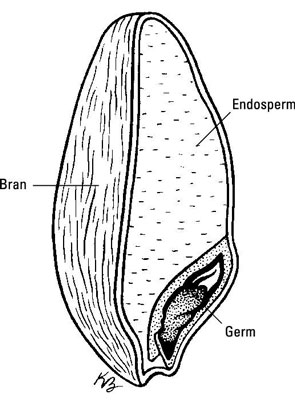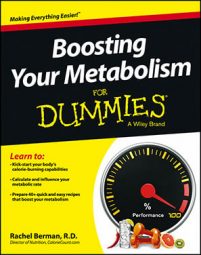Products containing more and more added sugar also hit the marketplace in the 1990s. These synthetic carbohydrates are not nutritious and slow down your metabolism. American’s consume too much of them, and they should be seriously reduced in your diet.
Minimize refined grains
When a grain is whole, it contains a germ, bran, and endosperm. When it’s refined, the bran and germ are removed — a process that also removes fiber, vitamins, and minerals. B vitamins, iron, and folic acid may be added back in, but not necessarily to the extent that they existed originally. And fiber is typically not added back in at all.

Enriched refined grains do offer some nutrition, but the original whole grain contains more nutrients to fuel your body and keep your metabolism moving. Also think about where you may find refined grains. Many of those products often also contain saturated fat, sodium, and other additives. Here are a few of the major sources of refined grains in the American diet:
White breads, rice, pastas
Tortillas, tacos, and pizza
Cakes, cookies, pies, pastries
Potato chips, corn chips, pretzels
According to a 2010 survey published in Journal of the American Dietetic Association, fewer than 10 percent of Americans consume enough whole grains; refined grains play a major role in most people’s diet. This puts you at increased risk for obesity and makes it more difficult to maintain a healthy weight.
If you consume more whole grains, you’ll be getting less of the stuff you don’t want and more real food as it’s found in nature — which is the stuff a boosted metabolism is made of.
Products can contain a mix of whole grains and refined grains. To make sure your product contains whole grains, you want one of the first ingredients to say whole wheat, whole grain, or whole something else. Ingredients are listed in order of weight. The closer an ingredient is to the top of the list, the more weight it comprises of the product.
You can usually spot a refined grain product if the label mentions it’s “enriched” and if it contains little fiber. Refined grain products, especially those with added solid fats and sodium, are at the top of your list to minimize.
Added sugars slow metabolism
Here’s a fun analogy when it comes to health effects: Whole grains are to refined grains as naturally occurring sugars are to what? The answer is added sugar, which makes up the majority of sugar Americans consume. In fact, on average a person in the United States gets about 22 teaspoons of added sugar per day, which adds up to about 330 calories!
Cutting out foods with added sugars, which typically only provide excess calories with little nutrition, can help you lose up to a pound per week.
Natural sugars are found in fruits, as fructose, and milk, as lactose, and in vegetables and some grains that your body uses for energy. Your body also uses processed sugar for energy, but typically, added (processed) sugars provide calories in excess of what your body needs and so get converted into fat.
Just like whole and refined grains, some products may contain both natural and added sugars. Typically, products which contain sources of milk and fruit have natural sugars but can also have added sugar. Reading a food label, it’s hard to tell which of the sugar is coming from natural or added sources.
That’s why there’s a push from the U.S. Food and Drug Administration to get “added sugar” on food labels. Many groups, such as the American Heart Association and the Center for Science in the Public Interest, are behind this effort. The idea is that such information on a label would be helpful for consumers to distinguish between the two kinds of sugar and make more healthful choices.
Added sugar includes what you sprinkle on your cereal or pour in your coffee, but added sugars are also found in so many foods to improve flavor, texture, and appearance.
| Food | Serving Size | Calories from Added Sugar per Serving |
|---|---|---|
| Carbonated soda | 12 ounce can | 132.5 |
| Lemonade | 1 cup | 99.2 |
| Cranberry sauce, canned, sweetened | 1 slice | 86.4 |
| Gumdrop candies | 10 each | 84.8 |
| Non-fat fruit yogurt | 6 ounces | 77.5 |
| Milk chocolate | 1 bar | 77.4 |
| Vanilla ice cream | 1/2 cup | 61.2 |
| Granola bar | 1 | 56.0 |
| Banana chips | 1 ounce | 39.6 |
| Ketchup | 1 tablespoon | 13.6 |
From USDA database for the added sugar content of selected food
Although there isn’t an “added sugar” row yet on a Nutrition Facts label, you can read through the ingredients to see if there is added sugar in the product. Remember the closer to the top of the list, the heavier the weight of that sugar, so you’re able to at least get a feel for the amount the product contains.
Sugar sneaks in under these names on labels:
Anything ending in –ose: Dextrose, sucrose, maltose, lactose, fructose
Syrup, corn syrup, and high fructose corn syrup
Brown sugar, malt sugar, inverted sugar, raw sugar, and plain ol’ sugar
Molasses, honey, and corn sweetener
Fruit juice concentrates
Limit high fructose corn syrup (HFCS)
Sucrose — also known as table sugar — is composed of the two sugars glucose and fructose, in roughly equal amounts. Studies suggest that it’s broken down and used by your body in the same way as when it digests the two sugars, although the jury is still out.
HFCS makes up about 40 percent of the added sugar in your food supply, because of its low cost relative to other sweeteners. You’ll find it in sodas, juices, cereals, salad dressings, nutrition bars — basically anything that is processed for a longer shelf-life.

